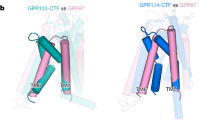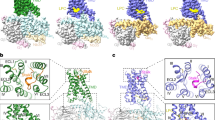Abstract
SgIGSF (spermatogenic immunoglobulin superfamily) is a recently identified intercellular adhesion molecule of the immunoglobulin superfamily. In a mast-cell cDNA library, we found a clone that resulted from the retention of intron 7 within the mature SgIGSF message. This clone was predicted to encode a soluble isoform of SgIGSF (sSgIGSF) with 336 amino-acid residues because its open reading frame ended just before the transmembrane domain. We constructed a plasmid expressing sSgIGSF fused to the human IgG Fc fragment at its C-terminus (sSgIGSF-Fc), and transfected it into COS-7 cells. The fusion protein was readily detectable in the culture supernatant. Solid-phase binding assay showed that sSgIGSF interacted directly the extracellular domain of membrane-bound SgIGSF (mSgIGSF). We next examined whether this interaction inhibited homophilic binding of mSgIGSF by aggregation assays using L cells that did not express mSgIGSF. A stable L-cell clone that overexpressed mSgIGSF aggregated with each other but not with mock-transfected L cells, indicating that a homophilic interaction of mSgIGSF mediated the aggregation. Addition of sSgIGSF-Fc inhibited the aggregation of L cells overexpressing mSgIGSF in a dose-dependent manner. Moreover, FACScan analyses revealed the specific binding of sSgIGSF-Fc to mSgIGSF expressed in L cells. Binding of sSgIGSF-Fc to mSgIGSF appeared to inhibit homophilic interactions of mSgIGSF.
This is a preview of subscription content, access via your institution
Access options
Subscribe to this journal
Receive 50 print issues and online access
$259.00 per year
only $5.18 per issue
Buy this article
- Purchase on Springer Link
- Instant access to full article PDF
Prices may be subject to local taxes which are calculated during checkout




Similar content being viewed by others
References
Budt M, Michely B, Müller MM, Reutter W and Lucka L . (2002). Biochem. Biophys. Res. Commun., 292, 749–755.
Fukami T, Fukuhara H, Kuramochi M, Maruyama T, Isogai K, Sakamoto M, Takamoto S and Murakami Y . (2003). Int. J. Cancer, 107, 53–59.
Fukami T, Satoh H, Fujita E, Maruyama T, Fukuhara H, Kuramochi M, Takamoto S, Momoi T and Murakami Y . (2002). Gene, 295, 7–12.
Hahne M, Lenter M, Jager U and Vestweber D . (1994). Eur. J. Immunol., 24, 421–428.
Ito A, Jippo T, Wakayama T, Morii E, Koma Y, Onda H, Nojima H, Iseki S and Kitamura Y . (2003a). Blood, 101, 2601–2608.
Ito A, Morii E, Maeyama K, Jippo T, Kim DK, Lee YM, Ogihara H, Hashimoto K, Kitamura Y and Nojima H . (1998). Blood, 91, 3210–3221.
Ito A, Okada M, Uchino K, Wakayama T, Koma Y, Iseki S, Tsubota N, Okita Y and Kitamura Y . (2003b). Lab. Invest., 83, 1175–1183.
Kaplan AJ, Chavin KD, Yagita H, Sandrin MS, Qin LH, Lin J, Lindenmayer G and Bromberg JS . (1993). J. Immunol., 151, 4022–4032.
Kumanogoh A, Watanabe C, Lee I, Wang X, Shi W, Araki H, Hirata H, Iwahori K, Uchida J, Yasui T, Matsumoto M, Yoshida K, Yakura H, Pan C, Parnes JR and Kikutani H . (2000). Immunity, 13, 621–631.
Kuramochi M, Fukuhara H, Nobukuni T, Kanbe T, Maruyama T, Ghosh HP, Pletcher M, Isomura M, Onizuka M, Kitamura T, Sekiya T, Reeves RH and Murakami Y . (2001). Nat. Genet., 27, 427–430.
Lee G, Spring FA, Parsons SF, Mankelow TJ, Peters LL, Koury MJ, Mohandas N, Anstee DJ and Chasis JA . (2003). Blood, 101, 1790–1797.
Masuda M, Yageta M, Fukuhara H, Kuramochi M, Maruyama T, Nomoto A and Murakami Y . (2002). J. Biol. Chem., 277, 31014–31019.
Meyer DM, Dustin ML and Carron CP . (1995). J. Immunol., 155, 3578–3584.
Mountain CF . (1997). Chest, 111, 1710–1717.
Nakamoto K, Ito A, Watabe K, Koma Y, Asada H, Yoshikawa K, Shinomura Y, Matsuzawa Y, Nojima H and Kitamura Y . (2001). Am. J. Pathol., 159, 1363–1374.
Pigott R, Dillon LP, Hemingway IH and Gearing AJ . (1992). Biochem. Biophys. Res. Commun., 187, 584–589.
Pletcher MT, Nobukuni T, Fukuhara H, Kuramochi M, Maruyama T, Sekiya T, Sussan T, Isomura M, Murakami Y and Reeves RH . (2001). Gene, 273, 181–189.
Suda T and Nagata S . (1994). J. Exp. Med., 179, 873–879.
Wakayama T, Koami H, Ariga H, Kobayashi D, Sai Y, Tsuji A, Yamamoto M and Iseki S . (2003). Biol. Preprod., 68, 1755–1763.
Wakayama T, Ohashi K, Mizuno K and Iseki S . (2001). Mol. Preprod. Dev., 60, 158–164.
Yageta M, Kuramochi M, Masuda M, Fukami T, Fukuhara H, Maruyama T, Shibuya M and Murakami Y . (2002). Cancer Res., 62, 5129–5133.
Acknowledgements
We thank Dr S Nagata for pEFBosFc, Dr T Akagi for pCX4bsr, and Dr A Kumanogoh and M Kohara for technical advice and assistance. The present work was supported by grants from the Ministry of Education, Culture, Sports, Science and Technology of Japan; the Osaka Cancer Society; the Sagawa foundation for promotion of cancer research; the Naito Foundation; and the Japanese Association for Metastasis Research.
Author information
Authors and Affiliations
Corresponding author
Rights and permissions
About this article
Cite this article
Koma, Yi., Ito, A., Wakayama, T. et al. Cloning of a soluble isoform of the SgIGSF adhesion molecule that binds the extracellular domain of the membrane-bound isoform. Oncogene 23, 5687–5692 (2004). https://doi.org/10.1038/sj.onc.1207761
Received:
Revised:
Accepted:
Published:
Issue Date:
DOI: https://doi.org/10.1038/sj.onc.1207761
Keywords
This article is cited by
-
The intracellular domain of cell adhesion molecule 1 is present in emphysematous lungs and induces lung epithelial cell apoptosis
Journal of Biomedical Science (2015)
-
Clinical significance of CADM1/TSLC1/IgSF4 expression in adult T-cell leukemia/lymphoma
Leukemia (2012)
-
CADM1 isoforms differentially regulate human mast cell survival and homotypic adhesion
Cellular and Molecular Life Sciences (2012)
-
Distinct role for c-kit receptor tyrosine kinase and SgIGSF adhesion molecule in attachment of mast cells to fibroblasts
Laboratory Investigation (2005)



